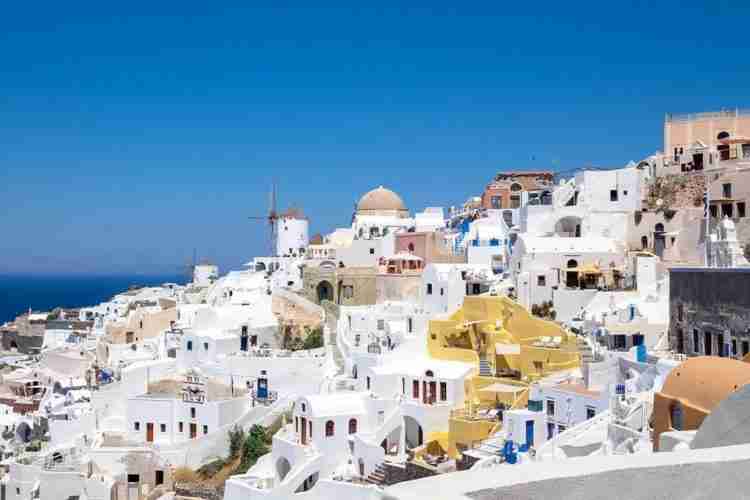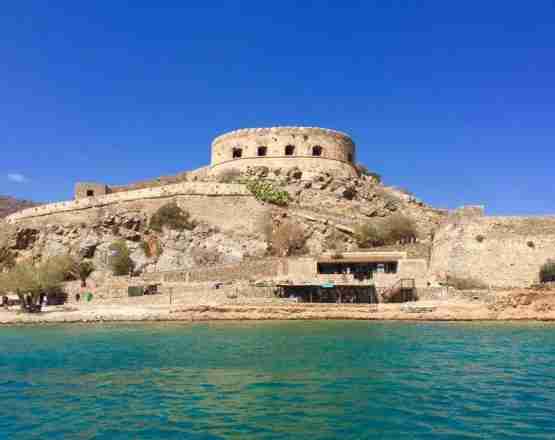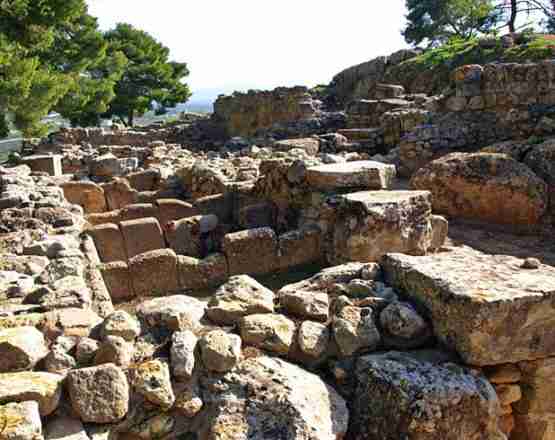Santorini

Dead civilizations
Can teach us still.
The Aegean Late Bronze Age was punctuated by violent events and destructions, both natural as well cultural, including the obliteration of Theran culture in Late Minoan IA (ca. 1614 BC), the destruction of Minoan civilization on Crete in Late Minoan IB (ca. 1450 BC), and the collapse of Mycenaean civilization at end of the Bronze Age (ca. 1180 BC).
What of of human trauma, of migration, or catalysts for identity formation.?Although each disaster resulted in destruction and some sort of movement, the causes of each violent event were different. The Theran eruption represents a natural disaster. The end of Aegean civilizations involved abandonment, perhaps with limited migration.
For the Aegean, the Late Bronze Age is ca. 1700-1180 BC. Writing from this period comes from Mesopotamia and Egypt, while for Greece what we possess are primarily administrative records and brief, un-deciphered texts. However, this period predates the systematic writing of history, a practice associated with Thucydides in the 5th c. BC
Mendenhall is referring specifically to Palestine, but notes that Aegean classifications are very similar if not identical. Cadogan has suggested more numerous minor events in-between these major ones including a variety of natural catastrophes other than earthquakes and comparable to those set out in the Old Testament, social revolts, piracy, factional struggles, and even accidents. Though often viewed as a “Dark Age,” the beginning of the Iron Age gives rise to a number of new social formations and cultures including the Greek polis, the Israelite culture, the Phoenicians, and the Philistines.
Destruction and conflict, with possible “ethnic cleansing” in the case of the Minoans. The third was perhaps, a peasant revolt and piracy, with additional conflict, followed by migration after the destruction of the Mycenaean palaces. Each upheaval has marked the landscape in its own way, but it is the destruction of Minoan civilization that has most resisted a satisfactory explanation. And, the process of the transition from Minoan to “Mycenoan” on Crete has neither been adequately addressed nor resolved
Emotion, Experience, and Prehistory
Attempts to address this even while speculative and subjective.Some experiences can be analyzed on various scales: reconstructing and interpreting patterns of deposition and patterns of movement within buildings and urban areas; and on a larger scale by reconstructing trade routes through the study of imports, administrative records, weather, and ship technology. These are based on reconstructing performativity and the embodied experience of individuals. For example, the Minoans deposited bronze figurines in caves and on peaks whereas ancient Cypriots placed them in temples. Emotions associated with these and with other routines are more difficult to apprehend, while the negative emotions of painful experience are absented in a triumphalist version of history.
Recent approaches have promoted ritual activity in prehistory as an event that includes emotional responses.Emotions are considered here with regard to the trauma of social upheaval alongside modern ethnography as an analogue for raising questions about how ancient events affected individuals who can only speak to us through material remains. Past and present construct each other, and our pasts frequently reflect our presents. The Minoans have regularly been analyzed as a construct mirroring the 20th century: as free individuals
Minoan is a modern designation for the pre-Greek inhabitants of Crete based on later legends of a king Minos and used here for the sake of convenience. We do not know what they called themselves, however they were called Keftiu in Egypt, Captaru in Akkadian texts, and Caphtorim in the Old Testament, suggesting an ethnonym similar to these. Recent strontium isotope ratio analysis of dental enamel and bone on individuals buried in Mainland style tombs according to Mycenaean custom in the region of Knossos following the period of LM IB destructions has shown that such individuals were born locally.This indicates that the beginning of the Mycenaeanization of Crete was quite possibly a local phenomenon. However, it also illustrates how ethnic identity can be transformed without large-scale migration. However, these results must also be treated with caution as the sample is small, the period post-dates the LM IB destructions, a period when ethnic change may have already been well under way.
with an extensive naval power engaging in trade and colonization as analogous to hippie cultures of the 1960s and second-wave feminists have idealized them as a matriarchy (Goodison and Morris 1998). Cadogan (1976) has famously observed that what we say about the Minoans says more about us than about them. We can safely say that each generation has its own Minoans.!!
What Happened to the People Behind the Pots?
The Theran eruption was preceded by earthquakes that led to the abandonment of the city, followed by obliteration of the center of the island The deposition of volcanic materials preserved the town of Akrotiri, creating a Bronze Age Pompei. Emphasis on the site means that little work has been done on the fate of the residents: where did they go and what did they do? How did their material and social circumstances change? They must have felt terror at being faced with a devastating earthquake, followed by a massive volcanic eruption, and tremendous sadness at leaving their refined and idealized lifestyles behind in a quest for survival. At the same time, they may have been relieved to survive this disaster! Evidence of the far reaching effects of this event range from Theran ash as part of the stratigraphy at Mochlos.on Crete, to offerings of Theran pumice, found as far away as Crete and Israel suggesting an emotional response in those who witnessed the effects of the cataclysm as well. Theran refugees, however, are more elusive.
Studies have associated the motifs on the treasures from the shaft graves at Mycenae with Theran art while frescoes from Tel Kabri, Israel and Tell el D‘aba show links with the Theran fresco painting tradition. The development of the Marine Style in LM IB Crete has been attributed to the migration of Theran crafters Further studies of these items may shed light on the fate of Theran crafters and their families, as migrants who brought welcome skills with them. We may speculate that items taken by migrating Therans became objects of barter in a quest for survival. Cloth production was an important industry on Thera and we might assume this activity was continued elsewhere. Migration raises questions about the nature of Bronze Age hospitality. What form did it take?It is tempting to speculate that some crafters sought patronage
In Houses and at Mochlos
Some 450 loomweights were found in the West House at Akrotiri
Population estimates for Akrotiri, a town of about 10-20 hectares, range from several hundred to thousands?
in Greece or the Near East, while other Therans migrated to Crete, based on the many similarities between Minoan and Theran culture as found in architecture, art, admin- istrative practices, and religious beliefs. The door of hospitality symbolizes the initial welcoming of the guest. It also carries the hosts’ expectation that the guest accepts the house rules and will conform to cultural norms making Crete a logical destination for the Therans who had appropriated many characteristics of Minoan culture.
What happened to the “Minoan” civilization after the destruction of their palaces in LM IB, and the appearance of Mycenaean culture on Crete, some 150 years after the destruction of Thera? Interpretations of their demise include a long decline following the Theran eruption, which included earthquakes and tsunamis, followed by increased factional competition and class warfare, and finally, a Mycenaeanization we find intentional dismantling of Minoan buildings between the Theran eruption and the destruction of Minoan civilization, these acts could be a local rejection of palatial authority, particularly that of Knossos.?
Knossos was thought to be undergoing extensive repairs in LM IB following the Theran eruption activities that led to local rebellion and subsequent invasion from the Mainland. Reducing such events to categories of destruction, neglects the emotional responses, which I would like to touch upon.!!
Where did the Minoans go?
Was there a “Minoan diaspora?” When some sought refuge in the hills, how many were killed? Were the elites “ethnically cleansed” and does it matter? How long might some of their families have occupied local territories before being displaced? Did some remain in their villages with little change in their lives, choosing to work for Mycenaean or Knossian overlords? Were only elites dis- placed? How might they have felt about what happened? Did non-elites eventually welcome “Mainlanders” as “liberators” from the exploitative domination of corvée labor imposed by “palace” elites? Does the term Aegean, apply indiscriminately to Mycenaeans and Minoans conveniently mask cultural and ethnic diversity and conflict?
Too frequently, the Minoans are discussed as a supplement, in terms of what they contributed to Greek or European civilization, rather than as having value in their own right
When we view the ruins of their once great civilization should we think about the individuals who created the things we categorize, classify, and interpret, and mourn them? Can we assume that all Minoans and Mycenaeans were skilled enough at making pottery to leave traces of their existence wherever they went? Is there a Minoan legacy? Is their suffering less important because it occurred so long ago?
A total of sixteen sites are known from the pre-eruption period, and with more than half of the island destroyed, the theoretical upper limit is estimated at 25 or 26,most recent estimates a population 1500-2000 for the site of Akrotiri, a reasonable number assuming an extended family of about 10-20 per house.
more than 3000 years ago? How will people 3000 years from now feel about the current suffering of traumatized peoples?
A nation’s ethnic or cultural identity is preserved through its material culture and is best symbolized by its monuments whereas cultural cleansing through their destruction becomes an early stage of ethnic cleansing.The term ethnic cleansing was coined in 1991, to refer to events inflicted by Serbia on Bosnia-Herzegovina.
Some have suggested that the Cretan landscape was abandoned and depopulated as indicated by the occupational gaps in much of east Crete between Minoan LM IB and Mycenaean LM IIIA1, about 1430 .Close parallels to the decorated pottery of Mochlos, but found at the more defensible, site of Halasmenos-Katalimata, suggest that the same population sought refuge in a less accessible area. This was followed by the foundation of fewer, simpler dwellings at Mochlos in LM II-III. An elite tomb from LM III Mochlos, rich in grave goods, has been interpreted as that of a Telestas or landowner possibly sent from Knossos where Linear B tablets indicate a feudal aristocracy.It has been suggested that not all of the mountain settlements founded after the destruction of the Minoan palaces were inhabited by those who had fled from large, coastal cities, but that they may also indicate migrant foundations by Mycenaean Greeks and Minoans returning home from abroad.
We can start by questioning whether the Mycenaeans arrived en masse, as part of small raiding parties, or were already present as mercenaries and migrants at Knossos.
Did we have peaceful integration, expulsion, and Minoan on Minoan attacks in Crete.Archaeomagnetic sampling of burnt mud- brick structures in LM IB Crete, indicate that destructions occurred across the island at different times: earlier in north central Crete, and later in the east at Palaikastro and at Kato Zakro These events indicate a protracted struggle, which contributed to displacement, anxiety, and trauma, occurring across the island as its ethnic character changed.
Would things have been different on Crete if there had been CNN, Twitter, international relief, a NATO intervention, an ethos of remembrance, or a global diaspora? Can considering the atrocities inflicted on past cultures as the suffering of individuals rather than as statistics teach us lessons in the present? How did trauma change the public culture in prehistory? Trauma as the reliving of violent experience can be expressed and documented through its inscription in memorials, serving as shared symbolism that can serve to bind a group together On Crete, this took the form of ruin cults that appeared among the Minoan palaces and villas in the early Iron Age, suggesting that emerging elites seeking new genealogical links with the past.
Violence, Violence Everywhere…
Ancient history sheds light on attitudes towards violence in antiquity while contemporary documentation of atrocity, trauma, and wartime violence may fill in gaps in prehistory. Although ethnographic analogy does not deliver the past as it was, it can bring us out of our contemporary hermeneutic of safety, security, and prosperity, and create a neutral space for discussing trauma Quite simply, it is less uncomfortable to discuss the trauma inflicted on an extinct culture than on ones where the wounds are still fresh or political claims are being contested.
Destruction and Identity
hospitality Philoxenia that Greece and modern East is famed for .However, one example of violence directed toward the Minoan population, is the disarticulated skull of a young woman, bearing a hole suggesting death by a blow to the head with a sharp object, from Building B1, Mochlos, a ceremonial building first damaged by earthquake, then purposely desecrated by breaking up of the stone Willful destruction of important buildings may indicate foreign destruction of, or local disillusion with existing power structures
Barring a natural disaster, the abandonment of homes is a gradual process resulting in displacement whereby ordinary civilians may flee their villages for fields or forests with a few possessions necessary for survival yet remain in eye contact with their homes, to see how things evolve. In some instances the displaced may return temporarily to abandoned homes to retrieve hidden possessions, care for livestock, or continue to work their land before leaving for good. Sometimes they may return to resume normal life under a new regime. The intent to return and retrieve goods isn’t always actuated because of further intimidation and destruction after the
the destruction of Sumer and Ur.
Thucydides tells us that after the Melians voluntarily surrendered to the Athenians, the men were put to death, the women and children were enslaved, and the town was re-populated with a colony of 500. In recounting an attack we are told of the Thebans: “the women and the menial servants were shouting and screaming from the houses all around”… and … “they were seized with fear, and abandoning their defense, fled in confusion about the city.” Such vivid descriptions contrast with Homeric genealogies as indicators of population movements.
A similar event of intentional destruction took place at Palaikastro in east Crete
A protracted struggle ending Minoan Crete might conform to the scenario outlined above, while a sudden destruction such as the earthquakes that preceded the eruption of Thera explains why so many valuables were left behind at that site.
The houses of the wealthy Minoans were violently destroyed and frequently plundered. A Mycenaean-style megaron sinking its foundations deep into the remains of the Minoan villa at Hagia Triada makes a statement of domination. Simpler houses, following abandonment, fall victim to lack of maintenance: first the roof collapses sealing the floor, the walls then fall in sealing the roof, with some stone perhaps reused for new buildings, till only the foundations remain .43 Heirlooms of a bygone era might evoke nostalgic memories for descendents of individuals that survived a traumatic past such as a stone blossom bowl of the Minoan period found several hun- dred years later in a Mycenaean style house at the post-palatial refuge site of Kavousi.
The decline of crafts as well as iconographic and architectural vocabulary not useful to the Mycenaeans, such as production of elaborate stone and bronze objects, is well documented for the period following the destruction of Minoan civilization.
The period of 1250-1150 BC that saw the end of the Bronze Age and the start of the Iron Age has been called “the traumatic century” The emergence of new communities in the early Iron Age is not unrelated to what went on before, yet a consideration of the interactions that precede the appearance of the Philistines, Phoenicians, Israelites, and the polis seldom enters the discussion, It was a time of violence, fragmentation, and change, where continuity was re-established through social rituals, that we are only beginning to comprehend.
Mycenaean-Style Deep or Bell-Shaped Bowl with Spiral Decoration,
Trauma, Nostalgia, and Ritualization
Ritual acts are connected to mental states .Objects evoke emotions in people through their embodiment of links to places, people, and events.
Dead civilizations have lessons to teach us about our own humanity and may serve as a politically neutral space for discussing traumas of cultures in the presence examining the emotional effects of violence as revealed in ancient historical texts, and analyzing the emotional significance of powerful sensory symbols (food, alcohol, and perfume) that served to evoke memories that bound communities together.


